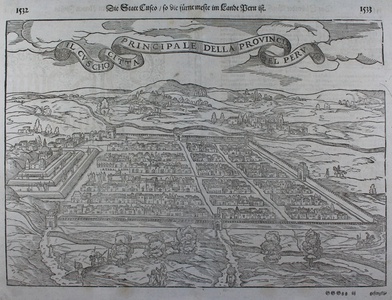| Method | Woodcut |
| Artist | Sebastian Münster after Giovanni Battista Ramusio |
| Published | [Basel, c.1600] |
| Dimensions | Image 272 x 375 mm, Sheet 296 x 405 mm |
| Notes |
Munster's view of Cusco, capital of Peru and the Inca empire, from the Cosmographia. The woodcut is a very close copy of Ramusio's 1556 view of the city, first published in his Raccolta di Navigationi et Viaggi. The major difference between the two blocks can be seen in the title at top. Where the original Ramusio title is emblazoned on an oriflamme, the Munster ribbon ends in a simple curl. The city of Cusco was initially founded at some point during the 10th or 11th centuries AD by the local Killke people, though by the 13th century, they had been subsumed by the growing Inca Empire. Under the Inca, the city became the Imperial capital for almost three hundred years. The centre of Inca government, society, and trade, Cusco was one of the most opulent cities in the world at the time of the Spanish conquest. Pizarro's men arrived in 1533, quickly stripping the buildings of their gold facades, and dismantling Inca temples and sacred spaces. Despite the despoliation, the Spaniards were overcome by the craftsmanship of the Inca, marveling that their stonework in particular surpassed any European example of the day. In a matter of years, the city was transformed by the conquerors, blending local art and architecture with colonial Spanish churches, casas, and public monuments. The first printed image of Cusco appeared in Pedro Cieza de Leon's Cronica del Peru in 1553, beginning a sixteenth century fascination with the city and its Aztec cousin, Tenochtitlan. Sebastian Münster (20th January 1488 - 26th May 1552) was a German cartographer, cosmographer, and theologian. A gifted scholar of Hebraic, Münster originally joined the Franciscans, but left the order in favour of the Lutheran Church. He was appointed to the University of Basel in 1529, and published a number of works in Latin, Greek, and Hebrew. His most celebrated works are his Latin edition of Ptolemy's Geographia in 1540, and the Cosmographia in 1544. The Cosmographia was the earliest German description of the world, an ambitious work of 6 volumes published in numerous editions in German, Latin, French, Italian, and Czech. Giovanni Battista Ramusio (1485-1557) was an Italian geographer, translator, author, and publisher. He is best known for the large series of traveller's accounts that he compiled, translated, and published as the Delle navigationi e Viaggi. The first volumes appeared during the 1550s, and were republished, added to, and translated into other languages throughout the second half of the sixteenth century. Condition: Central vertical fold, as issued. Minor staining to sheet. German letterpress text on verso. |
| Framing | unmounted |
| Price | £450.00 |
| Stock ID | 47465 |

